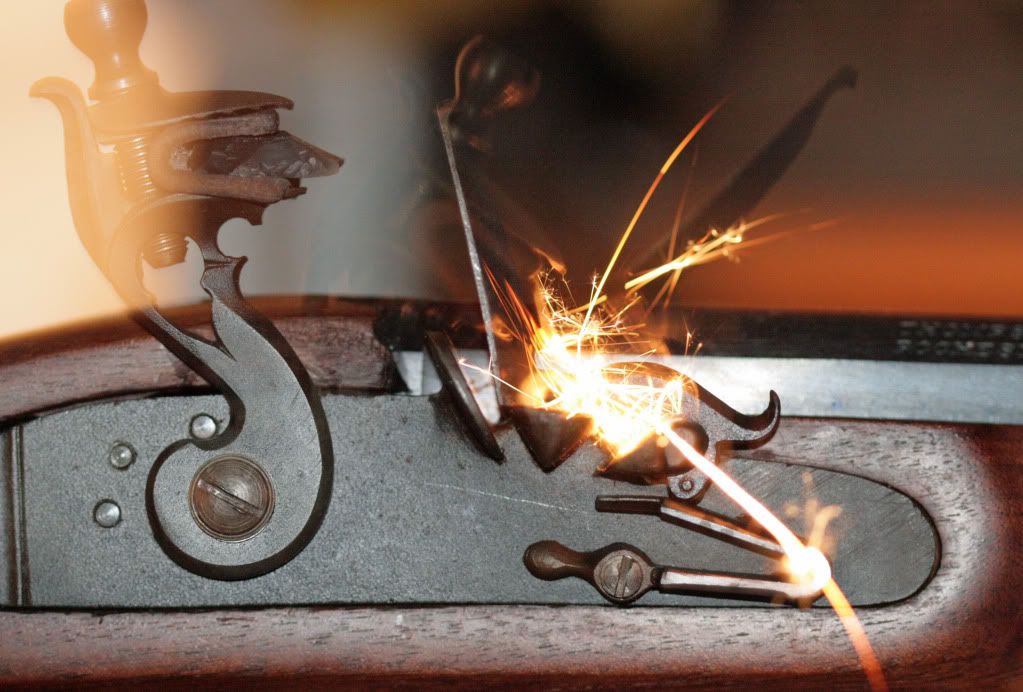Mr. Pletcher suggests everybody try to take a picture of your lock as it is working. I agree. It will tell you a lot. If you are observant, you may learn some facts that you may have thought wrong.
This is the L&R replacement lock for a GPR and/or a TC (very similar).

A lot of you, maybe most, think it is an upgrade over the factory locks that come with the rifles. It is not. It is different but it is not better.
One thing to notice right off is where the sparks tend to fall? They seem to be slightly ahead of the pan. Now let's consider the pan. It is narrow and deep. Deeper and more narrow than either the Lyman or TC factory lock. Both of them are wider and spread the prime out over a greater area. Equals a greater chance the prime will light off.
This lock produces a goodly supply of sparks but this lock also had to make a return trip to L&R for a second chance to get it right.
Just because the L&R comes with leaf springs and the others coil did not make it better. Some believe anything with leaf V type springs has to be better than a lock with coils springs.
You can see the cock is not blurred. That means the camera was not fast enough to catch it's fall until it came to rest. But there does seem to be some rebound with the frizzen as is does show some blur.
At the end of the cock's travel it is exacly where a good lock should have it. Directly pointing in the pan.
One more thing, you may notice is the flint is getting pretty dull. Flints need to be sharp to work. Really? Maybe again not as sharp as thought. You might tell this flint has been used many, many times but is still working pretty well.
Anyway try this easy test on your own equipment, you may just learn soemthing you didn't know.
EXIF data Canon XTi with 100mm f2.8 Macro lens, ISO 100, TV 1 sec, AV f4.
This is the L&R replacement lock for a GPR and/or a TC (very similar).

A lot of you, maybe most, think it is an upgrade over the factory locks that come with the rifles. It is not. It is different but it is not better.
One thing to notice right off is where the sparks tend to fall? They seem to be slightly ahead of the pan. Now let's consider the pan. It is narrow and deep. Deeper and more narrow than either the Lyman or TC factory lock. Both of them are wider and spread the prime out over a greater area. Equals a greater chance the prime will light off.
This lock produces a goodly supply of sparks but this lock also had to make a return trip to L&R for a second chance to get it right.
Just because the L&R comes with leaf springs and the others coil did not make it better. Some believe anything with leaf V type springs has to be better than a lock with coils springs.
You can see the cock is not blurred. That means the camera was not fast enough to catch it's fall until it came to rest. But there does seem to be some rebound with the frizzen as is does show some blur.
At the end of the cock's travel it is exacly where a good lock should have it. Directly pointing in the pan.
One more thing, you may notice is the flint is getting pretty dull. Flints need to be sharp to work. Really? Maybe again not as sharp as thought. You might tell this flint has been used many, many times but is still working pretty well.
Anyway try this easy test on your own equipment, you may just learn soemthing you didn't know.
EXIF data Canon XTi with 100mm f2.8 Macro lens, ISO 100, TV 1 sec, AV f4.






